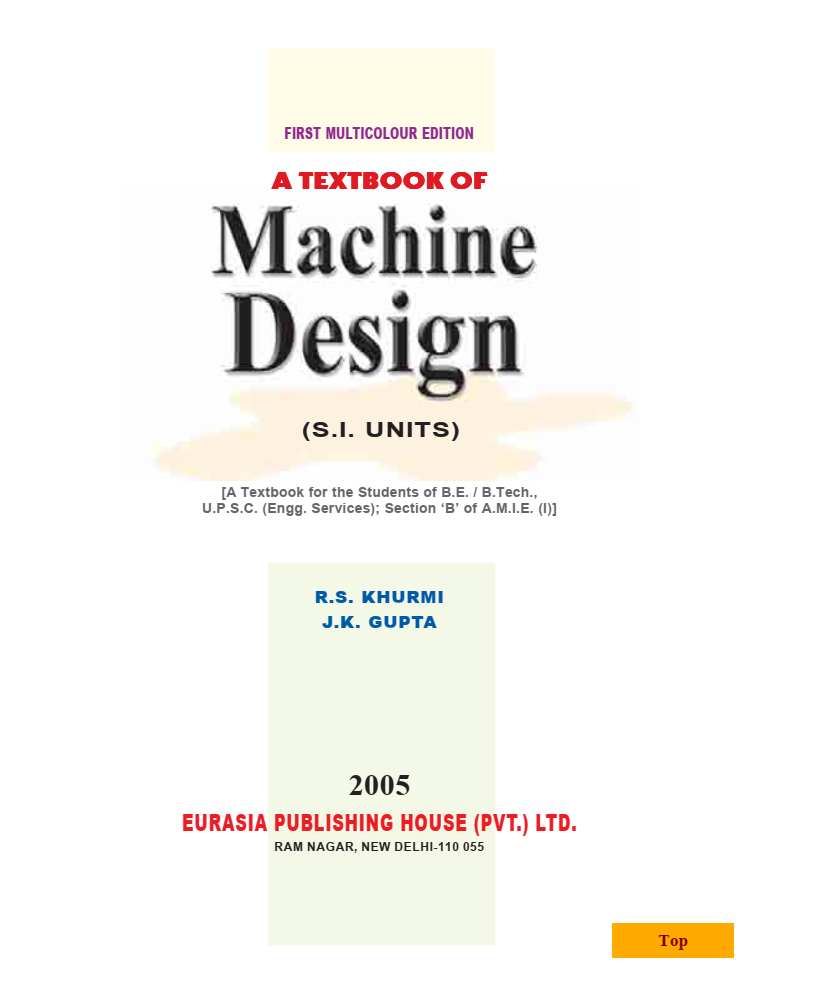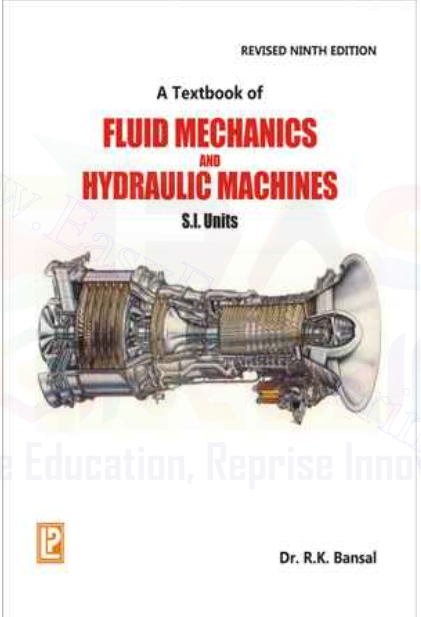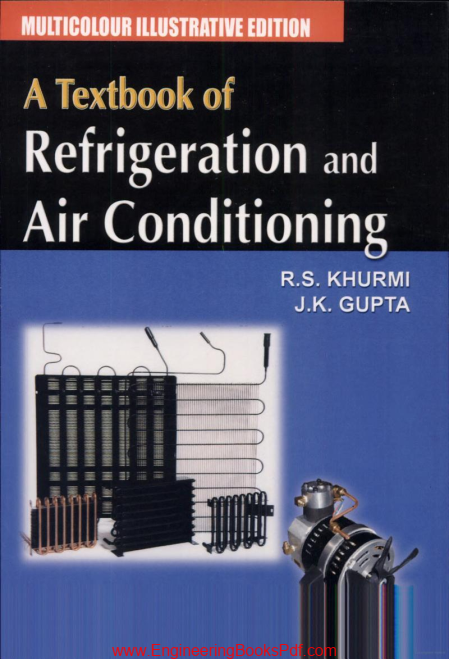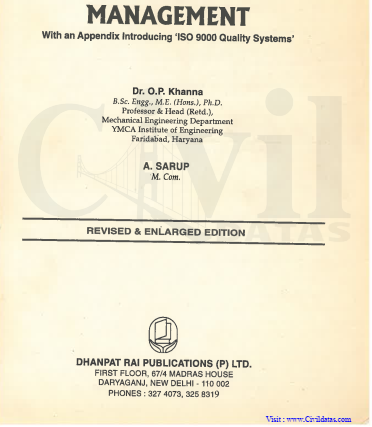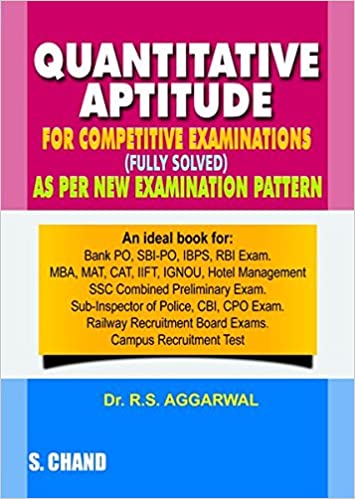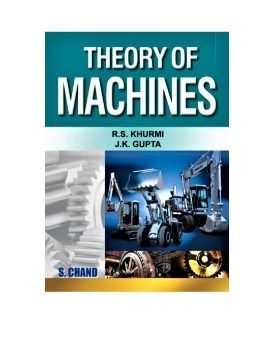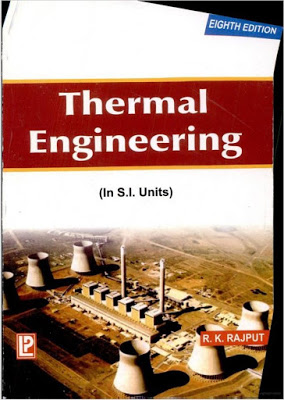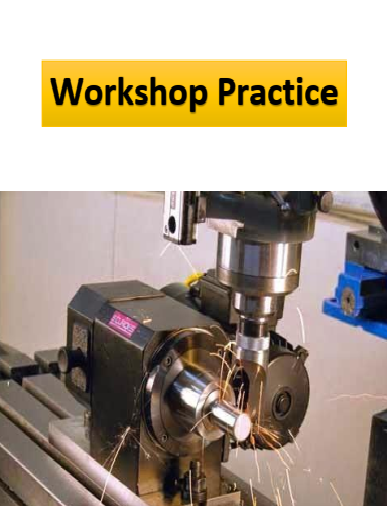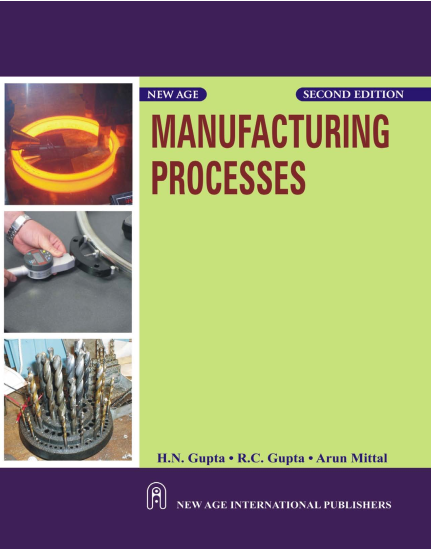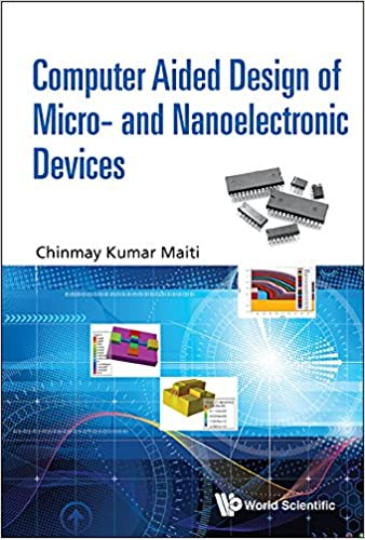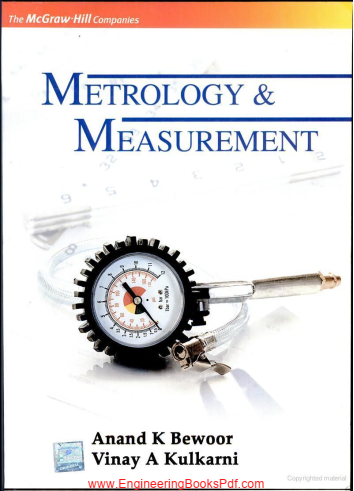1. Introduction ...1–15 1. Definition. 2. Classifications of Machine Design. 3. General Considerations in Machine Design. 4. General Procedure in Machine Design. 5. Fundamental Units. 6. Derived Units. 7. System of Units. 8. S.I Units (International System of Units). 9. Metre. 10. Kilogram. 11. Second. 12. Presentation of Units and their values. 13. Rules for S.I. Units. 14. Mass and Weight. 15. Inertia. 16. Laws of Motion. 17. Force. 18. Absolute and Gravitational Units of Force. 19. Moment of a Force. 20. Couple. 21. Mass Density. 22. Mass Moment of Inertia. 23. Angular Momentum. 24. Torque. 25. Work. 26. Power. 27. Energy. 2. Engineering Materials and Their Properties ...16–52 1. Introduction. 2. Classification of Engineering Materials. 3. Selection of Materials for Engineering Purposes. 4. Physical Properties of Metals. 5. Mechanical Properties of Metals. 6. Ferrous Metals. 7. Cast Iron. 8. Types of Cast Iron. 9. Alloy Cast Iron. 10. Effect of Impurities on Cast Iron. 11. Wrought Iron. 12. Steel. 13. Steels Designated on the Basis of Mechanical Properties. 14. Steels Designated on the Basis of Chemical Composition. 15. Effect of Impurities on Steel. 16. Free Cutting Steels. 17. Alloy Steels. 18. Indian Standard Designation of Low and Medium Alloy Steels. 19. Stainless Steel. 20. Heat Resisting Steels. 21. Indian Standard Designation of High Alloy Steels (Stainless Steel and Heat Resisting Steel). 22. High Speed Tool Steels. 23. Indian Standard Designation of High Speed Tool Steel. 24. Spring Steels. 25. Heat Treatment of Steels. 26. Non-ferrous Metals. 27. Aluminium. 28. Aluminium Alloys. 29. Copper. 30. Copper Alloys. 31. Gun Metal. 32. Lead. 33. Tin. 34. Bearing Metals. 35. Zinc Base Alloys. 36. Nickel Base Alloys. 37. Non-metallic Materials. CONTENTS(viii) 3. Manufacturing Considerations in Machine Design ...53–86 1. Introduction. 2. Manufacturing Processes. 3. Casting. 4. Casting Design. 5. Forging. 6. Forging Design. 7. Mechanical Working of Metals. 8. Hot Working. 9. Hot Working Processes. 10. Cold Working. 11. Cold Working Processes. 12. Interchangeability. 13. Important Terms Used in Limit System. 14. Fits. 15. Types of Fits. 16. Basis of Limit System. 17. Indian Standard System of Limits and Fits. 18. Calculation of Fundamental Deviation for Shafts. 19. Calculation of Fundamental Deviation for Holes. 20. Surface Roughness and its Measurement. 21. Preferred Numbers. 4. Simple Stresses in Machine Parts ...87–119 1. Introduction. 2. Load. 3. Stress. 4. Strain. 5. Tensile Stress and Strain. 6. Compressive Stress and Strain. 7. Young's Modulus or Modulus of Elasticity. 8. Shear Stress and Strain 9. Shear Modulus or Modulus of Rigidity. 10. Bearing Stress. 11. Stress-strain Diagram. 12. Working Stress. 13. Factor of Safety. 14. Selection of Factor of Safety. 15. Stresses in Composite Bars. 16. Stresses Due to Change in Temperature—Thermal Stresses. 17. Linear and Lateral Strain. 18. Poisson's Ratio. 19. Volumetric Strain. 20. Bulk Modulus. 21. Relation Between Bulk Modulus and Young's Modulus. 22. Relation Between Young's Modulus and Modulus of Rigidity. 23. Impact Stress. 24. Resilience. 5. Torsional and Bending Stresses in Machine Parts ...120–180 1. Introduction. 2. Torsional Shear Stress. 3. Shafts in Series and Parallel. 4. Bending Stress in Straight Beams. 5. Bending Stress in Curved Beams. 6. Principal Stresses and Principal Planes. 7. Determination of Principal Stresses for a Member Subjected to Bi-axial Stress. 8. Application of Principal Stresses in Designing Machine Members. 9. Theories of Failure Under Static Load. 10. Maximum Principal or Normal Stress Theory (Rankine’s Theory). 11. Maximum Shear Stress Theory (Guest’s or Tresca’s Theory). 12. Maximum Principal Strain Theory (Saint Venant’s Theory). 13. Maximum Strain Energy Theory (Haigh’s Theory). 14. Maximum Distortion Energy Theory (Hencky and Von Mises Theory). 15. Eccentric Loading—Direct and Bending Stresses Combined. 16. Shear Stresses in Beams.(ix) 6. Variable Stresses in Machine Parts ...181–223 1. Introduction. 2. Completely Reversed or Cyclic Stresses. 3. Fatigue and Endurance Limit. 4. Effect of Loading on Endurance Limit—Load Factor. 5. Effect of Surface Finish on Endurance Limit—Surface Finish Factor. 6. Effect of Size on Endurance Limit—Size Factor. 7. Effect of Miscellaneous Factors on Endurance Limit. 8. Relation Between Endurance Limit and Ultimate Tensile Strength. 9. Factor of Safety for Fatigue Loading. 10. Stress Concentration. 11. Theoretical or Form Stress Concentration Factor. 12. Stress Concentration due to Holes and Notches. 13. Methods of Reducing Stress Concentration. 14. Factors to be Considered while Designing Machine Parts to Avoid Fatigue Failure. 15. Stress Concentration Factor for Various Machine Members. 16. Fatigue Stress Concentration Factor. 17. Notch Sensitivity. 18. Combined Steady and Variable Stresses. 19. Gerber Method for Combination of Stresses. 20. Goodman Method for Combination of Stresses. 21. Soderberg Method for Combination of Stresses. 22. Combined Variable Normal Stress and Variable Shear Stress. 23. Application of Soderberg's Equation. 7. Pressure Vessels ...224–260 1. Introduction. 2. Classification of Pressure Vessels. 3. Stresses in a Thin Cylindrical Shell due to an Internal Pressure. 4. Circumferential or Hoop Stress. 5. Longitudinal Stress. 6. Change in Dimensions of a Thin Cylindrical Shell due to an Internal Pressure. 7. Thin Spherical Shells Subjected to an Internal Pressure. 8. Change in Dimensions of a Thin Spherical Shell due to an Internal Pressure. 9. Thick Cylindrical Shell Subjected to an Internal Pressure. 10. Compound Cylindrical Shells. 11. Stresses in Compound Cylindrical Shells. 12. Cylinder Heads and Cover Plates. 8. Pipes and Pipe Joints ...261–280 1. Introduction. 2. Stresses in Pipes. 3. Design of Pipes. 4. Pipe Joints. 5. Standard Pipe Flanges for Steam. 6. Hydraulic Pipe Joint for High Pressures. 7. Design of Circular Flanged Pipe Joint. 8. Design of Oval Flanged Pipe Joint. 9. Design of Square Flanged Pipe Joint.(x) 9. Riveted Joints ...281–340 1. Introduction. 2. Methods of Riveting. 3. Material of Rivets. 4. Essential Qualities of a Rivet. 5. Manufacture of Rivets. 6. Types of Rivet Heads. 7. Types of Riveted Joints. 8. Lap Joint. 9. Butt Joint. 10. Important Terms Used in Riveted Joints. 11. Caulking and Fullering. 12. Failures of a Riveted Joint. 13. Strength of a Riveted Joint. 14. Efficiency of a Riveted Joint. 15. Design of Boiler Joints. 16. Assumptions in Designing Boiler Joints. 17. Design of Longitudinal Butt Joint for a Boiler. 18. Design of Circumferential Lap Joint for a Boiler. 19. Recommended Joints for Pressure Vessels. 20. Riveted Joint for Structural Use – Joints of Uniform Strength (Lozenge Joint). 21. Eccentric Loaded Riveted Joint. 10. Welded Joints ...341–376 1. Introduction. 2. Advantages and Disadvantages of Welded Joints over Riveted Joints. 3. Welding Processes. 4. Fusion Welding. 5. Thermit Welding. 6. Gas Welding. 7. Electric Arc Welding. 8. Forge Welding. 9. Types of Welded Joints. 10. Lap Joint. 11. Butt Joint. 12. Basic Weld Symbols. 13. Supplementary Weld Symbols. 14. Elements of a Weld Symbol. 15. Standard Location of Elements of a Welding Symbol. 16. Strength of Transverse Fillet Welded Joints. 17. Strength of Parallel Fillet Welded Joints. 18. Special Cases of Fillet Welded Joints. 19. Strength of Butt Joints. 20. Stresses for Welded Joints. 21. Stress Concentration Factor for Welded Joints. 22. Axially Loaded Unsymmetrical Welded Sections. 23. Eccentrically Loaded Welded Joints. 24. Polar Moment of Inertia and Section Modulus of Welds. 11. Screwed Joints ...377–430 1. Introduction. 2. Advantages and Disadvantages of Screwed Joints. 3. Important Terms used in Screw Threads. 4. Forms of Screw Threads. 5. Location of Screwed Joints. 6. Common Types of Screw Fastenings. 7. Locking Devices. 8. Designation of Screw Threads. 9. Standard Dimensions of Screw Threads. 10. Stresses in Screwed Fastening due to Static Loading. 11. Initial Stresses due to Screwing Up Forces. 12. Stresses due to External Forces. 13. Stress due to Combined Forces. 14. Design of Cylinder Covers. 15. Boiler Stays. 16. Bolts of Uniform Strength. 17. Design of a Nut.(xi) 18. Bolted Joints under Eccentric Loading. 19. Eccentric Load Acting Parallel to the Axis of Bolts. 20. Eccentric Load Acting Perpendicular to the Axis of Bolts. 21. Eccentric Load on a Bracket with Circular Base. 22. Eccentric Load Acting in the Plane Containing the Bolts. 12. Cotter and Knuckle Joints ...431–469 1. Introduction. 2. Types of Cotter Joints. 3. Socket and Spigot Cotter Joint. 4. Design of Socket and Spigot Cotter Joint. 5. Sleeve and Cotter Joint. 6. Design of Sleeve and Cotter Joint. 7. Gib and Cotter Joint. 8. Design of Gib and Cotter Joint for Strap End of a Connecting Rod. 9. Design of Gib and Cotter Joint for Square Rods. 10. Design of Cotter Joint to Connect Piston Rod and Crosshead. 11. Design of Cotter Foundation Bolt. 12. Knuckle Joint.13. Dimensions of Various Parts of the Knuckle Joint.14. Methods of Failure of Knuckle Joint. 15. Design Procedure of Knuckle Joint. 16. Adjustable Screwed Joint for Round Rods (Turn Buckle). 17. Design of Turn Buckle. 13. Keys and Coupling ...470–508 1. Introduction. 2. Types of Keys. 3. Sunk Keys. 4. Saddle Keys. 5. Tangent Keys. 6. Round Keys. 7. Splines. 8. Forces acting on a Sunk Key. 9. Strength of a Sunk Key. 10. Effect of Keyways. 11. Shaft Couplings. 12. Requirements of a Good Shaft Coupling. 13. Types of Shaft Couplings. 14. Sleeve or Muff Coupling. 15. Clamp or Compression Coupling. 16. Flange Coupling. 17. Design of Flange Coupling. 18. Flexible Coupling. 19. Bushed Pin Flexible Coupling. 20. Oldham Coupling. 21. Universal Coupling. 14. Shafts ...509–557 1. Introduction. 2. Material Used for Shafts. 3. Manufacturing of Shafts. 4. Types of Shafts. 5. Standard Sizes of Transmission Shafts. 6. Stresses in Shafts. 7. Maximum Permissible Working Stresses for Transmission Shafts. 8. Design of Shafts. 9. Shafts Subjected to Twisting Moment Only. 10. Shafts Subjected to Bending Moment Only. 11. Shafts Subjected to Combined Twisting Moment and Bending Moment. 12. Shafts Subjected to Fluctuating Loads. 13. Shafts Subjected to Axial Load in addition to Combined Torsion and Bending Loads. 14. Design of Shafts on the Basis of Rigidity.(xii) 15. Levers ...558–599 1. Introduction. 2. Application of Levers in Engineering Practice. 3. Design of a Lever. 4. Hand Levers. 5. Foot Lever. 6. Cranked Lever. 7. Lever for a Lever Safety Valve. 8. Bell Crank Lever. 9. Rocker Arm for Exhaust Valve. 10. Miscellaneous Levers. 16. Columns and Struts ...600–623 1. Introduction. 2. Failure of a Column or Strut. 3. Types of End Conditions of Columns. 4. Euler’s Column Theory. 5. Assumptions in Euler’s Column Theory. 6. Euler’s Formula. 7. Slenderness Ratio. 8. Limitations of Euler’s Formula. 9. Equivalent Length of a Column. 10. Rankine’s Formula for Columns. 11. Johnson’s Formula for Columns. 12. Long Columns Subjected to Eccentric Loading. 13. Design of Piston Rod. 14. Design of Push Rods. 15. Design of Connecting Rod. 16. Forces Acting on a Connecting Rod. 17. Power Screws ...624–676 1. Introduction. 2. Types of Screw Threads used for Power Screws. 3. Multiple Threads. 4. Torque Required to Raise Load by Square Threaded Screws. 5. Torque Required to Lower Load by Square Threaded Screws. 6. Efficiency of Square Threaded Screws. 7. Maximum Efficiency of Square Threaded Screws. 8. Efficiency vs. Helix Angle. 9. Overhauling and Self-locking Screws. 10. Efficiency of Self Locking Screws. 11. Coefficient of Friction. 12. Acme or Trapezoidal Threads. 13. Stresses in Power Screws. 14. Design of Screw Jack. 15. Differential and Compound Screws. 18. Flat Belt Drives ...677–714 1. Introduction. 2. Selection of a Belt Drive. 3. Types of Belt Drives. 4. Types of Belts. 5. Material used for Belts. 6. Working Stresses in Belts. 7. Density of Belt Materials. 8. Belt Speed. 9. Coefficient of Friction Between Belt and Pulley 10. Standard Belt Thicknesses and Widths. 11. Belt Joints. 12. Types of Flat Belt Drives. 13. Velocity Ratio of a Belt Drive. 14. Slip of the Belt. 15. Creep of Belt. 16. Length of an Open Belt Drive. 17. Length of a Cross Belt Drive. 18. Power transmitted by a Belt. 19. Ratio of Driving Tensions for Flat Belt Drive. 20. Centrifugal Tension. 21. Maximum Tension in the Belt. 22. Condition for Transmission of Maximum Power. 23. Initial Tension in the Belt.(xiii) 19. Flat Belt Pulleys ...715–726 1. Introduction. 2. Types of Pulleys for Flat Belts. 3. Cast Iron Pulleys. 4. Steel Pulleys. 5. Wooden Pulleys. 6. Paper Pulleys. 7. Fast and Loose Pulleys. 8. Design of Cast Iron Pulleys. 20. V-Belt and Rope Drives ...727–758 1. Introduction. 2. Types of V-belts and Pulleys. 3. Standard Pitch Lengths of V-belts. 4. Advantages and Disadvantages of V-belt Drive over Flat Belt Drive. 5. Ratio of Driving Tensions for V-belt. 6. V-flat Drives. 7. Rope Drives. 8. Fibre Ropes. 9. Advantages of Fibre Rope Drives. 10. Sheave for Fibre Ropes. 11. Ratio of Driving Tensions for Fibre Rope. 12. Wire Ropes. 13. Advantages of Wire Ropes. 14. Construction of Wire Ropes. 15. Classification of Wire Ropes. 16. Designation of Wire Ropes. 17. Properties of Wire Ropes. 18. Diameter of Wire and Area of Wire Rope.19. Factor of Safety for Wire Ropes.20. Wire Rope Sheaves and Drums. 21. Wire Rope Fasteners. 22. Stresses in Wire Ropes. 23. Procedure for Designing a Wire Rope. 21. Chain Drives ...759–775 1. Introduction. 2. Advantages and Disadvantages of Chain Drive over Belt or Rope Drive. 3. Terms Used in Chain Drive. 4. Relation Between Pitch and Pitch Circle Diameter. 5. Velocity Ratio of Chain Drives. 6. Length of Chain and Centre Distance. 7. Classification of Chains. 8. Hoisting and Hauling Chains. 9. Conveyor Chains. 10. Power Transmitting Chains. 11. Characteristics of Roller Chains. 12. Factor of Safety for Chain Drives. 13. Permissible Speed of Smaller Sprocket. 14. Power Transmitted by Chains. 15. Number of Teeth on the Smaller or Driving Sprocket or Pinion. 16. Maximum Speed for Chains. 17. Principal Dimensions of Tooth Profile. 18. Design Procedure for Chain Drive. 22. Flywheel ...776–819 1. Introduction. 2. Coefficient of Fluctuation of Speed. 3. Fluctuation of Energy. 4. Maximum Fluctuation of Energy. 5. Coefficient of Fluctuation of Energy. 6. Energy Stored in a Flywheel. 7. Stresses in a Flywheel Rim. 8. Stresses in Flywheel Arms. 9. Design of Flywheel Arms. 10. Design of Shaft, Hub and Key. 11. Construction of Flywheels.(xiv) 23. Springs ...820–884 1. Introduction. 2. Types of Springs. 3. Material for Helical Springs. 4. Standard Size of Spring Wire. 5. Terms used in Compression Springs. 6. End Connections for Compression Helical Springs. 7. End Connections for Tension Helical Springs. 8. Stresses in Helical Springs of Circular Wire. 9. Deflection of Helical Springs of Circular Wire. 10. Eccentric Loading of Springs. 11. Buckling of Compression Springs. 12. Surge in Springs. 13. Energy Stored in Helical Springs of Circular Wire. 14. Stress and Deflection in Helical Springs of Non-circular Wire. 15. Helical Springs Subjected to Fatigue Loading. 16. Springs in Series. 17. Springs in Parallel. 18. Concentric or Composite Springs. 19. Helical Torsion Springs. 20. Flat Spiral Springs. 21. Leaf Springs. 22. Construction of Leaf Springs. 23. Equalised Stresses in Spring Leaves (Nipping). 24. Length of Leaf Spring Leaves. 25. Standard Sizes of Automobile Suspension Springs. 26. Material for Leaf Springs. 24. Clutchces ...885–916 1. Introduction. 2. Types of Clutches. 3. Positive Clutches. 4. Friction Clutches. 5. Material for Friction Surfaces. 6. Considerations in Designing a Friction Clutch. 7. Types of Friction Clutches. 8. Single Disc or Plate Clutch. 9. Design of a Disc or Plate Clutch. 10. Multiple Disc Clutch. 11. Cone Clutch. 12. Design of a Cone Clutch. 13. Centrifugal Clutch. 14. Design of a Centrifugal Clutch. 25. Brakes ...917–961 1. Introduction. 2. Energy Absorbed by a Brake. 3. Heat to be Dissipated during Braking. 4. Materials for Brake Lining. 5. Types of Brakes. 6. Single Block or Shoe Brake. 7. Pivoted Block or Shoe Brake. 8. Double Block or Shoe Brake. 9. Simple Band Brake. 10. Differential Band Brake. 11. Band and Block Brake. 12. Internal Expanding Brake. 26. Sliding Contact Bearings ...962–995 1. Introduction.2. Classification of Bearings. 3. Types of Sliding Contact Bearings.4. Hydrodynamic Lubricated Bearings. 5. Assumptions in Hydrodynamic Lubricated Bearings. 6. Important Factors for the Formation of Thick Oil Film in Hydrodynamic Lubricated Bearings. 7. Wedge Film Journal Bearings. 8. Squeeze Film Journal Bearings. 9. Properties of Sliding Contact Bearing Materials.10. Materials used for Sliding Contact Bearings.11. Lubricants.(xv) 12. Properties of Lubricants.13. Terms used in Hydrodynamic Journal Bearings.14. Bearing Characteristic Number and Bearing Modulus for Journal Bearings. 15. Coefficient of Friction for Journal Bearings.16. Critical Pressure of the Journal Bearing. 17. Sommerfeld Number. 18. Heat Generated in a Journal Bearing. 19. Design Procedure for Journal Bearings. 20. Solid Journal Bearing. 21. Bushed Bearing. 22. Split Bearing or Plummer Block. 23. Design of Bearing Caps and Bolts. 24. Oil Grooves. 25. Thrust Bearings. 26. Foot-step or Pivot Bearings. 27. Collar Bearings. 27. Rolling Contact Bearings ...996–1020 1. Introduction. 2. Advantages and Disadvantages of Rolling Contact Bearings Over Sliding Contact Bearings. 3. Types of Rolling Contact Bearings. 4. Types of Radial Ball Bearings. 5. Standard Dimensions and Designation of Ball Bearings. 6. Thrust Ball Bearings. 7. Types of Roller Bearings. 8. Basic Static Load Rating of Rolling Contact Bearings. 9. Static Equivalent Load for Rolling Contact Bearings. 10. Life of a Bearing. 11. Basic Dynamic Load Rating of Rolling Contact Bearings. 12. Dynamic Equivalent Load for Rolling Contact Bearings. 13. Dynamic Load Rating for Rolling Contact Bearings under Variable Loads. 14. Reliability of a Bearing. 15. Selection of Radial Ball Bearings. 16. Materials and Manufacture of Ball and Roller Bearings. 17. Lubrication of Ball and Roller Bearings. 28. Spur Gears ...1021–1065 1. Introduction. 2. Friction Wheels. 3. Advantages and Disadvantages of Gear Drives. 4. Classification of Gears.5. Terms used in Gears. 6. Condition for Constant Velocity Ratio of Gears–Law of Gearing. 7. Forms of Teeth. 8. Cycloidal Teeth. 9. Involute Teeth. 10. Comparison Between Involute and Cycloidal Gears.11. Systems of Gear Teeth.12. Standard Proportions of Gear Systems.13. Interference in Involute Gears.14. Minimum Number of Teeth on the Pinion in order to Avoid Interference.15. Gear Materials. 16. Design Considerations for a Gear Drive.17. Beam Strength of Gear Teeth-Lewis Equation. 18. Permissible Working Stress for Gear Teeth in Lewis Equation. 19. Dynamic Tooth Load. 20. Static Tooth Load. 21. Wear Tooth Load. 22. Causes of Gear Tooth Failure. 23. Design Procedure for Spur Gears. 24. Spur Gear Construction. 25. Design of Shaft for Spur Gears. 26. Design of Arms for Spur Gears.(xvi) 29. Helical Gears ...1066–1079 1. Introduction. 2. Terms used in Helical Gears. 3. Face Width of Helical Gears. 4. Formative or Equivalent Number of Teeth for Helical Gears. 5. Proportions for Helical Gears. 6. Strength of Helical Gears. 30. Bevel Gears ...1080–1100 1. Introduction. 2. Classification of Bevel Gears. 3. Terms used in Bevel Gears. 4. Determination of Pitch Angle for Bevel Gears. 5. Proportions for Bevel Gears. 6. Formative or Equivalent Number of Teeth for Bevel Gears—Tredgold's Approximation. 7. Strength of Bevel Gears. 8. Forces Acting on a Bevel Gear. 9. Design of a Shaft for Bevel Gears. 31. Worm Gears ...1101–1124 1. Introduction 2. Types of Worms 3. Types of Worm Gears. 4. Terms used in Worm Gearing. 5. Proportions for Worms. 6. Proportions for Worm Gears. 7. Efficiency of Worm Gearing. 8. Strength of Worm Gear Teeth. 9. Wear Tooth Load for Worm Gear. 10. Thermal Rating of Worm Gearing. 11. Forces Acting on Worm Gears. 12. Design of Worm Gearing. 32. Internal Combustion Engine Parts ...1125–1214 1. Introduction. 2. Principal Parts of an I. C. Engine. 3. Cylinder and Cylinder Liner. 4. Design of a Cylinder. 5. Piston. 6. Design Considerations for a Piston. 7. Material for Pistons. 8. Pistion Head or Crown . 9. Piston Rings. 10. Piston Skirt. 12. Piston Pin. 13. Connecting Rod. 14. Forces Acting on the Connecting Rod. 15. Design of Connecting Rod. 16. Crankshaft. 17. Material and Manufacture of Crankshafts. 18. Bearing Pressure and Stresses in Crankshfts. 19. Design Procedure for Crankshaft. 20. Desig
There are no reviews for this eBook.
There are no comments for this eBook.
You must log in to post a comment.
Log in
